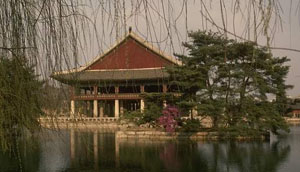|
|
History |
 |
||||
|
History |
Choson Dynasty The Choson period followed the Koryo period, from 1392 to 1910. One of the most important developments architecturally of the Choson Dynasty was the rise of Confucianism. Confucian shrines and public and private academies flourished during this time period. Pagoda building effectively ended during this time because it was the exclusive domain of Buddhism, with only two notable examples: the seven-storied pagoda at Naksan-sa Temple, and the ten-storied pagoda in Pagoda Park in Seoul. While Buddhism never actually "died out" during this period, it was never officially recognized by the royalty. Because the monks tended to have rural temples set high in the mountains, the state itself rarely bothered to deal with the Buddhist monks. The commoners, meanwhile, still visited the temples as they had all along. The
Chusimp’o style was used heavily throughout Korea during the early
portion of the Choson Dynasty because the relative simplicity of the style was more in tune with
Confucianist teachings. The middle
Choson period displayed a very decorative tendency on both the interior and
exterior. This came about
because of Anti-Manchurian feelings within the scholarly community; as a
result, native Korean elements and expressions began to be fully explored
within the architecture. The late portion of this Dynasty saw the development of the Ik-kong bracket, in which the bracket complex is reduced to a simple block of wood carved into the shape of a bracket. This move was based almost entirely on economic reasons: the country was in a state of poverty, and it enabled them to still repair and build buildings.
|
|
||||




